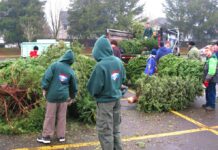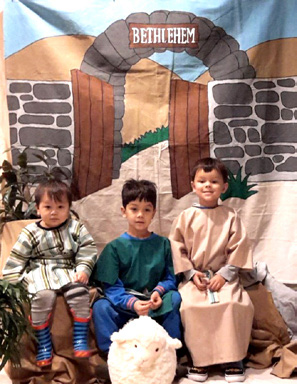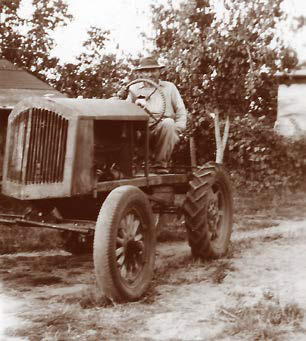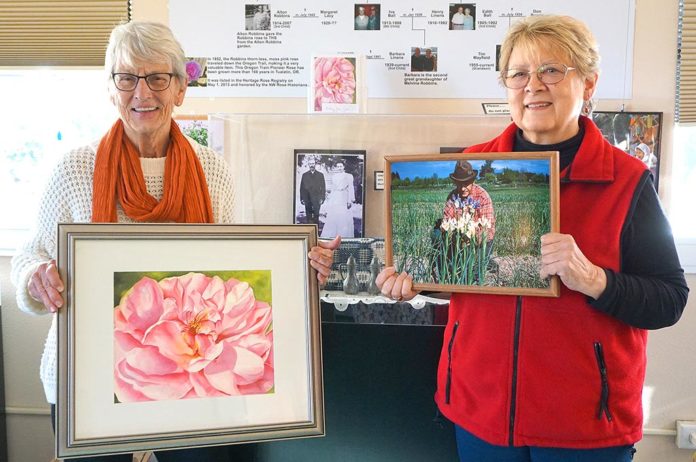
Barbara Stinger and Sandra Lafky Carlson proudly display pictures of their family’s historic flowers at the Tualatin Historical Society. Each flower withstood being passed down through multiple generations. Both women feel a significant sense of responsibility to continue the legacy of their ancestors by caring for these flowers.
Stinger describes her family’s flower as an ugly rose. Roses are typically pictured as the prototypical elegant flower with long stems and large petals. Her family’s rose, the pink Robbins Rose, is more of a creature than a rose. A thick, prickly moss covers the flower’s stems. The underwhelming appearance distracts from its sweet smell. Despite its less than beautiful look, this rose was a treasured possession of Nathaniel and Nancy Robbins as they traveled on the Oregon Trail in 1852.
“It must have been very special to them to bring it with them on the trail. They didn’t have a garden when they arrived here. You had to bring your own seeds. It’s not something you can buy, it’s something that has to be given. They are very special,” Stinger says.
This rose has been cherished for generations. Alton Robbins, Stinger’s uncle, was the fourth-generation descendant of Nathaniel and Nancy Robbins. Before he passed away, he donated one of the roses to the Tualatin Heritage Center. This unique breed of rose now grows at Stinger’s home and in the Tualatin Historical Society’s garden. In 2013, the pink Robbins Rose was listed in the Heritage Rose Registry and recognized by the Northwest Rose Historians. For Stinger, the rose symbolizes a long family legacy.
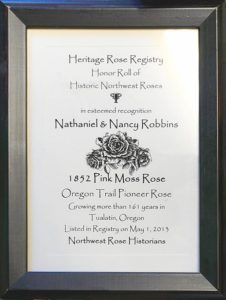
“Anything that has to do with family excites me. The older the better!” Stinger exclaims.
Carlson sits next to Stinger with her well-known flower, which originated in the Tualatin area. Carlson leans in as she shares about her family’s historic flower, a white iris named Tualatin Manette. This Dutch iris was propagated by Mark Lafky, Carlson’s grandfather. The rare white iris was named after Mark’s wife, Manette Lafky.
“It was very sweet that he named the iris after my grandmother,” Carlson says.
Stinger tilts her head and agrees, “Very romantic.”
Mark served on the local school board, and Manette taught Sunday School in the same building which now houses the Tualatin Historical Society. Mark attended Oregon Agricultural College (now known as Oregon State University) and was known to other farmers as a ‘scientific farmer.’ His schooling allowed him to cultivate the land to create a proper growing environment for irises. Mark discovered an early blooming white iris, a rare mutation, amongst the commonplace blue irises. He decided to separate this white iris to keep it from reverting back to the surrounding blue irises. He knew this flower was something others would be interested in buying, because he saw the white irises selling quickly in the market. Eventually, he filed for a patent to protect this unique flower.
Carlson remembers watching her grandfather prepare the soil with his two horses and a plow. Later, she participated in harvesting the bulbs.
“Of course, to harvest the bulbs you had to turn over the soil and then hire about a dozen people in July to dig and pull them up. I remember doing that as a kid. It was the hottest, dirtiest job, because you had to crawl along the ground and pull up the stocks and cut off the bulbs,” Carlson explains.
Although the flower and its patent were sold, Carlson keeps her family’s iris growing in her yard. The white irises appear every late April to early May at the Lafky House, Lafky Park and the Tualatin Historical Society.
The Robbins Rose and Tualatin Manette Iris are more than flowers. They are symbols of the greater legacy of the Tualatin valley. Stinger, Carlson and others like them carry on a small piece of their family’s history by cultivating these flowers. It’s more than just growing plants. By sharing the history of these flowers with their community, they keep the stories of their families alive. While these might just be mere flowers to the casual observer, they are actually ties to the past. Historical treasures, like these, can be found everywhere. One just needs to look.




